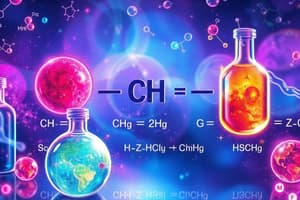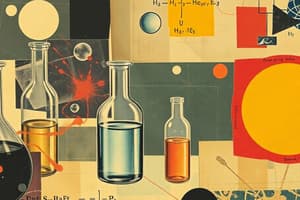Podcast
Questions and Answers
What is the result of burning a magnesium ribbon in air?
What is the result of burning a magnesium ribbon in air?
- It forms magnesium oxide. (correct)
- It melts into liquid form.
- It turns into magnesium sulfate.
- It disappears completely.
Which change occurs when food is cooked?
Which change occurs when food is cooked?
- Chemical change altering the composition. (correct)
- Physical change with no identity alteration.
- Only the temperature changes.
- No change occurs.
What can be inferred when grapes undergo fermentation?
What can be inferred when grapes undergo fermentation?
- A chemical change occurs. (correct)
- A physical change takes place.
- The identity of the grapes remains the same.
- Fermentation is a process that preserves the grapes.
In which situation does a chemical reaction NOT occur?
In which situation does a chemical reaction NOT occur?
What is a common evidence that a chemical change has taken place during respiration?
What is a common evidence that a chemical change has taken place during respiration?
When a zinc granule reacts with hydrochloric acid, what is the expected outcome?
When a zinc granule reacts with hydrochloric acid, what is the expected outcome?
Which of the following statements is true regarding chemical reactions?
Which of the following statements is true regarding chemical reactions?
Assess the change that occurs when food is digested in the body.
Assess the change that occurs when food is digested in the body.
Which of the following observations indicates that a chemical reaction has taken place?
Which of the following observations indicates that a chemical reaction has taken place?
What is the role of magnesium in the word-equation 'Magnesium + Oxygen → Magnesium oxide'?
What is the role of magnesium in the word-equation 'Magnesium + Oxygen → Magnesium oxide'?
In the equation 'Magnesium + Oxygen → Magnesium oxide', what does the arrow indicate?
In the equation 'Magnesium + Oxygen → Magnesium oxide', what does the arrow indicate?
Which of the following is NOT a method to determine if a chemical reaction has occurred?
Which of the following is NOT a method to determine if a chemical reaction has occurred?
What is formed as a product when magnesium is burned in the presence of oxygen?
What is formed as a product when magnesium is burned in the presence of oxygen?
Which of the following statements about reactants and products is correct?
Which of the following statements about reactants and products is correct?
What does a word-equation in chemistry represent?
What does a word-equation in chemistry represent?
During a reaction, if temperature increases, what can be inferred?
During a reaction, if temperature increases, what can be inferred?
What is the reddish brown powder that forms on iron called?
What is the reddish brown powder that forms on iron called?
Which metal develops a black coating due to corrosion?
Which metal develops a black coating due to corrosion?
What process occurs when fats and oils are oxidized?
What process occurs when fats and oils are oxidized?
What method can be used to prevent oxidation in food products?
What method can be used to prevent oxidation in food products?
What type of reaction is rusting classified as?
What type of reaction is rusting classified as?
What gas is often used to flush chips bags to prevent oxidation?
What gas is often used to flush chips bags to prevent oxidation?
Which of the following is a potential consequence of corrosion?
Which of the following is a potential consequence of corrosion?
What happens to the physical state of metals during corrosion?
What happens to the physical state of metals during corrosion?
What is the total number of atoms of oxygen in the products of the equation Fe + H2O → Fe3O4 + H2?
What is the total number of atoms of oxygen in the products of the equation Fe + H2O → Fe3O4 + H2?
Which element should be balanced first when balancing the equation Fe + H2O → Fe3O4 + H2?
Which element should be balanced first when balancing the equation Fe + H2O → Fe3O4 + H2?
What is the correct coefficient for H2O needed to balance the oxygen in the equation?
What is the correct coefficient for H2O needed to balance the oxygen in the equation?
What will happen if the equation is altered by changing the formula of H2O?
What will happen if the equation is altered by changing the formula of H2O?
How many hydrogen atoms are present in the reactants of the equation Fe + H2O → Fe3O4 + H2?
How many hydrogen atoms are present in the reactants of the equation Fe + H2O → Fe3O4 + H2?
What must you do to balance the Fe atoms in the equation Fe + H2O → Fe3O4 + H2?
What must you do to balance the Fe atoms in the equation Fe + H2O → Fe3O4 + H2?
Why can't the formula of H2O be modified to balance the oxygen?
Why can't the formula of H2O be modified to balance the oxygen?
Before balancing the equation, how many total atoms are there in the reactants?
Before balancing the equation, how many total atoms are there in the reactants?
What is true about a balanced chemical equation?
What is true about a balanced chemical equation?
In a decomposition reaction, what happens?
In a decomposition reaction, what happens?
Which type of reaction occurs when energy is absorbed?
Which type of reaction occurs when energy is absorbed?
What occurs during a displacement reaction?
What occurs during a displacement reaction?
Which is a characteristic of a double displacement reaction?
Which is a characteristic of a double displacement reaction?
In the reaction 2PbO(s) + C(s) → 2Pb(s) + CO2(g), which statement is correct?
In the reaction 2PbO(s) + C(s) → 2Pb(s) + CO2(g), which statement is correct?
Which product is formed when dilute hydrochloric acid reacts with iron fillings?
Which product is formed when dilute hydrochloric acid reacts with iron fillings?
What is oxidized in a chemical reaction?
What is oxidized in a chemical reaction?
What is indicated by the arrow in a chemical equation?
What is indicated by the arrow in a chemical equation?
What does a balanced chemical equation ensure?
What does a balanced chemical equation ensure?
Which of the following represents a skeletal chemical equation?
Which of the following represents a skeletal chemical equation?
Which chemical formula correctly represents magnesium burning in air?
Which chemical formula correctly represents magnesium burning in air?
Why are chemical equations made more concise using chemical formulae?
Why are chemical equations made more concise using chemical formulae?
What must be counted to determine if a chemical equation is balanced?
What must be counted to determine if a chemical equation is balanced?
What does the law of conservation of mass state?
What does the law of conservation of mass state?
What is the resulting compound when zinc reacts with sulfuric acid?
What is the resulting compound when zinc reacts with sulfuric acid?
Flashcards
Chemical Reaction
Chemical Reaction
A process where the chemical composition of a substance changes, resulting in the formation of new substances with different properties.
Reactants
Reactants
The initial substances that undergo transformation in a chemical reaction.
Products
Products
The substances produced as a result of a chemical reaction.
Chemical Equation
Chemical Equation
Signup and view all the flashcards
Combustion
Combustion
Signup and view all the flashcards
Oxidation
Oxidation
Signup and view all the flashcards
Reduction
Reduction
Signup and view all the flashcards
Quantity of Reactants
Quantity of Reactants
Signup and view all the flashcards
Word Equation
Word Equation
Signup and view all the flashcards
Arrow in a Word Equation
Arrow in a Word Equation
Signup and view all the flashcards
Signs of a Chemical Reaction
Signs of a Chemical Reaction
Signup and view all the flashcards
Balanced Chemical Equation
Balanced Chemical Equation
Signup and view all the flashcards
Arrow
Arrow
Signup and view all the flashcards
Skeletal Chemical Equation
Skeletal Chemical Equation
Signup and view all the flashcards
Law of Conservation of Mass
Law of Conservation of Mass
Signup and view all the flashcards
Coefficients
Coefficients
Signup and view all the flashcards
Chemical Formula
Chemical Formula
Signup and view all the flashcards
Balancing Chemical Equations
Balancing Chemical Equations
Signup and view all the flashcards
Corrosion
Corrosion
Signup and view all the flashcards
Rancidity
Rancidity
Signup and view all the flashcards
Antioxidants
Antioxidants
Signup and view all the flashcards
Oxidation (definition)
Oxidation (definition)
Signup and view all the flashcards
Reduction (definition)
Reduction (definition)
Signup and view all the flashcards
Combination Reaction
Combination Reaction
Signup and view all the flashcards
Decomposition Reaction
Decomposition Reaction
Signup and view all the flashcards
Exothermic Reaction
Exothermic Reaction
Signup and view all the flashcards
Endothermic Reaction
Endothermic Reaction
Signup and view all the flashcards
Displacement Reaction
Displacement Reaction
Signup and view all the flashcards
Double Displacement Reaction
Double Displacement Reaction
Signup and view all the flashcards
Precipitation Reaction
Precipitation Reaction
Signup and view all the flashcards
Study Notes
Chemical Reactions and Equations
- Chemical reactions involve changes in the nature and identity of substances.
- Chemical reactions involve the breaking and formation of chemical bonds.
- Chemical reactions can be observed by changes in state, color, evolution of a gas, and/or temperature.
- A chemical equation represents a chemical reaction using chemical formulas and symbols.
Chemical Equations
- Chemical formulas (e.g., Mg, O2, MgO) replace words in word equations.
- Word equations show reactants converting to products.
- A chemical equation is balanced when the number of atoms of each element is the same on both sides of the arrow.
- Reactants are written on the left side, products on the right side of the arrow.
- Balanced equations reflect the law of conservation of mass.
- Physical states (s, l, g, aq) are included for clarification and completeness.
Types of Chemical Reactions
Combination Reactions
- Two or more reactants combine to form a single product.
- Example: 2H2 + O2 → 2H2O (formation of water)
Decomposition Reactions
- A single reactant breaks down into two or more products.
- Example: 2H2O → 2H2 + O2 (decomposition of water)
Displacement Reactions
- A more reactive element displaces a less reactive element from a compound.
- Example: Mg + CuSO4 → MgSO4 + Cu (magnesium displacing copper)
Double Displacement Reactions
- Two compounds exchange ions to form two new compounds.
- Example: Na2SO4 + BaCl2 → BaSO4 + 2NaCl (formation of barium sulfate precipitate)
Oxidation and Reduction
- Oxidation is the gain of oxygen or loss of hydrogen.
- Reduction is the loss of oxygen or gain of hydrogen.
- Oxidation-reduction (redox) reactions involve both oxidation and reduction.
- Example: 2Cu + O2 → 2CuO (copper oxide formation)
Studying That Suits You
Use AI to generate personalized quizzes and flashcards to suit your learning preferences.




